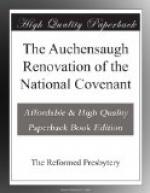“God is love;” and reciprocal love constitutes “the bond of perfectness” between God and rational creatures. Communion with God is the supreme felicity and highest honor of which angels and men are capable. The first emanation of divine love revealed to us was displayed in the covenant of works; although not called a covenant, the narrative contains all the elements essential to a federal deed, comprising a summary of the whole moral law. Thus the sovereign love of God was manifested through the medium of law and covenant inseparably combined; and this is the Lord’s manner of dealing with mankind till the present time.
That covenant was made with us in Adam as our common father and public representative. By the breach of it we are born in Adam’s image and “children of wrath;” for the principle of representative identification pervades the moral universe. Our rational and social nature fits us both for personal and federal responsibility.
When we had “destroyed ourselves” by apostasy from God, then did God “show the exceeding riches of his grace in his kindness toward us through Christ Jesus.” The gift of his Son to be a covenant head to sinners is God’s highest, and most glorious demonstration of his ineffable love. The breadth, and length, and depth, and height of the love of Christ passeth knowledge; and the displays of this love through the covenant of grace will doubtless furnish matter of admiration to holy angels, and of adoring gratitude to redeemed sinners throughout eternity. Rev. i: 5, 6.
Ever since our fall in Adam God has dealt with our sinful race by covenant. This covenant was made with Christ as Mediator between God and man, and as the representative of all whom the Father gave him to be redeemed and brought to glory. John xvii: 2. Accordingly, the Lord Jesus, immediately on the fall of our first parents, entered upon his work of mediation. To them first he announced his commission, declaring his purpose to “bruise the serpent’s head—to destroy the works of the devil.” Gen. iii: 15; 1 John iii: 8. Christ is given “for a witness to the people; a leader and commander to the people; to have power over all flesh, that he should give eternal life to as many as the Father hath given him.”
Throughout the whole of the mediatorial administration the law and the covenant are distinct, though inseparably connected: and although many covenants are mentioned in the Scriptures, and even distinguished as old and new. Jer. xxxi: 31; Heb. viii: 8; yet we must understand these as only different and successive modes of administering one and the same Covenant of Grace. This covenant was proclaimed before the deluge by prophets, as Enoch and Noah; after the flood by patriarchs; then by the ministry of Moses and other prophets, when John the Baptist and the Messiah in person proclaimed it; and from the day of Pentecost till the end of the world is the last dispensation—still, the covenant is immutably the same. The most solemn and memorable act of covenanting with God was at Horeb, otherwise called Sinai, when the Israelites were first and formally organized in ecclesiastical and civil relations. Then “Judah was his sanctuary, and Israel his dominion.” Ps. cxiv: 2.




